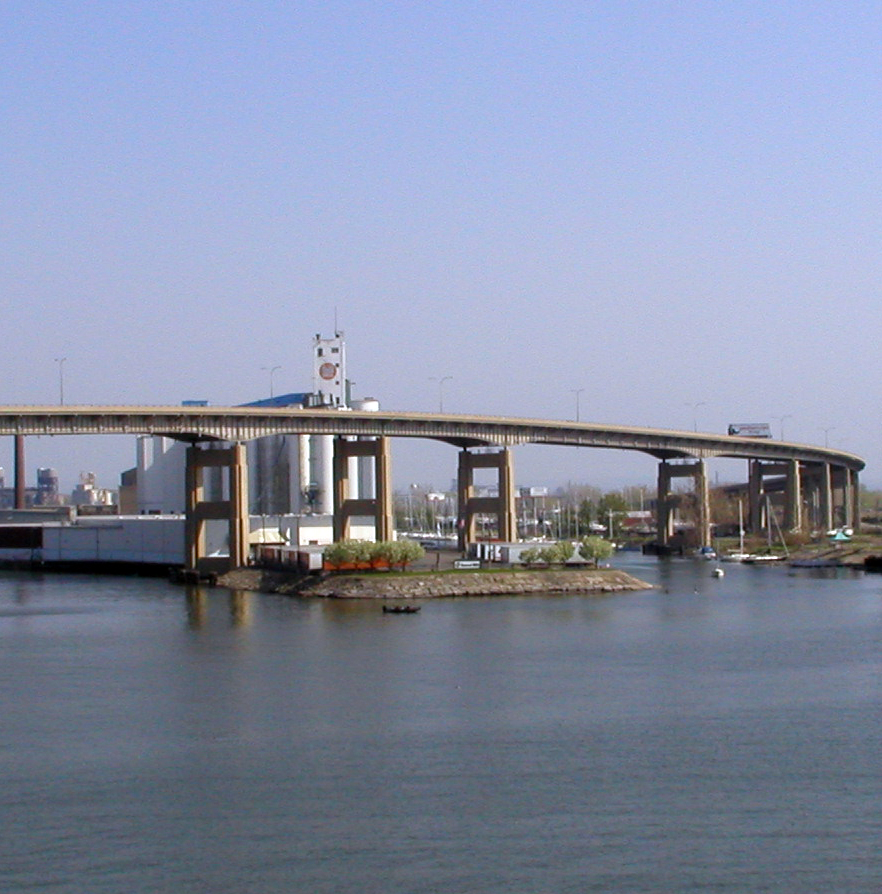The Buffalo Skyway is one of the city’s most iconic landmarks — but it’s also one of the most controversial.
The Skyway consists of an elevated bridge across the Buffalo River on Route 5 connecting Downtown Buffalo with the Northern end of the Buffalo Harbor.

Despite its detractors, when it was constructed in 1955 the Skyway was considered “a real achievement in the traffic world,” as written in a letter to the editor in a now-defunct Buffalo newspaper called the Courier-Express, according to Buffalo Rising.
“If ever a route like that was needed, it was needed in this city,” the letter said.
Read on to learn about the history of the Skyway, why it was constructed and what it represented to the city in the mid-20th century.
Why The Skyway Was Built
According to Buffalo Rising, a “high-level bridge” along the Buffalo River was first proposed in 1922 in a report prepared by the Buffalo Common Council’s City Planning Committee. It was proposed as a way to reduce traffic, prevent accidents and address the conflict between automobiles and water and rail transport.
As millions of Americans became capable of purchasing cars, traffic exploded and with more automobiles and traffic came more crashes. In 1929, the city’s ratio of traffic deaths to population was the fourth highest in the nation, behind only Chicago, Cleveland, and Milwaukee—like Buffalo, all cities in which vehicular traffic was restricted by water. As a result, cities like Buffalo had to figure out how to redesign themselves to accommodate the automobile revolution.
Besides the water restrictions, Buffalo’s belt-line railroads also contributed to excessive traffic and the funneling of traffic through five main places in the city. This, along with Buffalo’s population approaching a postwar peak around 1950, created an untenable situation that led to increased calls for change. Proponents argued that an elevated bridge would allow passing ships to travel to Buffalo while alleviating traffic problems in the city.
In the late 1940s, the Buffalo Chamber of Commerce agreed to build a high-level bridge as a means to alleviate traffic congestion and delays at lift-bridges, which had been a major point of frustration for 40,000 employees at the Bethlehem Steel Plant in Lackawanna and other factories. They also believed it would serve as a tourist attraction, highlighting the city’s natural beauty.
At the time, Buffalo’s Outer Harbor was considered unsightly and run-down, with old buildings and areas used for automobile storage. Proponents believed the construction of the bridge would help initiate a cleanup and improvement of the area.
A Symbol of Progress & Hope
The Skyway project was unlike anything most in the city had ever seen. According to Buffalo Rising, Courier-Express reporters had called the first day of construction in 1951 a “day of rejoicing” and marveled at the statistics that would describe the structure: 5,904 feet long, 22,000 tons of steel deck, 10,000 cubic yards of concrete, and 10,000 gallons of paint.
The Skyway’s construction was as much symbolic as it was functional, serving as a ray of hope for future waterfront development, increased tourism and the promise of fanfare and positive public relations for the city, according to Buffalo Rising.
According to Buffalo Rising, because the central span of the Skyway had to cross the Buffalo River and the City Ship Canal without ground support, its roadbed had to be at least 110 feet high, and its “four great curves” were a function of its required course out of the city, over the river and ship canal, and down to Fuhrmann Boulevard and the Lake Erie waterfront. These necessities helped create its unique, modern design that was lauded by residents, journalists and politicians.
At its grand opening in 1955, Dexter P. Rumsey, chairman of the Citizens’ Committee for Better Roads in Buffalo and Erie County, called the Skyway “the finest public improvement the community had received in decades,” and “the start of a new era—a period of civic progress in mass transportation,” according to Buffalo Rising.
Unlike previous bridges, the Skyway was considered a work of art in its own right due to its use of reinforced concrete (rather than the traditional iron and steel), representing a “modern, functionalist aesthetic” that was popular during the time period. The structure was also representative of an era in which developers sought to “dominate nature” in the construction of mammoth skyscrapers and bridges.
Early motorists on the Skyway were enthralled by the “breathtaking” views of docks, lake steamers, the Coast Guard base, grain elevators and city buildings as they crossed the bridge. As driving became a pleasure for an increasing number of Americans, many cruised the Skyway for fun to get a top-level view of the city unlike any other. And the “ribbon of steel and concrete” of the bridge was a symbol of the city’s prosperity, power and progress at a time when the nation was moving toward a more automobile-focused and technologically-driven future.
According to Western New York Heritage, the Skyway was considered part of a large plan for the “rapid transit of automobiles” around the city of Buffalo. Its construction spurred several additional highway projects in the area, including the first section of the Kensington Expressway, the Scajaquada Expressway, and another elevated bridge over the Union Ship Canal at the Buffalo-Lackawanna line, which were all built over the next decade according to Buffalo Rising.
In the following decades, however, the decline of Buffalo’s industrial factories made the Skyway less useful to the city. According to Empire State Development, since the region’s major steel factories closed in the 1980s, the land along the Skyway is now primarily used for waterfront recreation rather than heavy manufacturing. This change has made many question whether the Skyway is still relevant and useful today.
Future of the Buffalo Skyway
Today, the Skyway is still a major transportation route into and around the city. But many activists, journalists and politicians believe it has become more of a hindrance than a help.
Over the 15 years, there have been increasing calls to shut down the elevated highway, in large part due to frequent winter closures due to weather, a high rate of accidents and the high cost of maintenance, according to Western New York Heritage.
In addition to these issues, the bridge is seen as a barrier to one of the city’s best assets: its waterfront. Critics of the Skyway argue that tearing it down will help increase development on the Lake Erie waterfront at the Outer Harbor. Far from the attraction it was considered 60 years ago, activists now consider the Skyway a “dinosaur” of eras past and an ugly structure unworthy of preservation.
Rep. Brian Higgins has said that the Skyway is obsolete and unsafe and does not conform to today’s highway standards. This becomes a nuisance when there are accidents or hazardous weather conditions, resulting in 200 diversions from the Skyway each year, according to WIVB. But politicians have yet to come up with a viable alternative, so the Skyway is here to stay for now.
The Skyway is undoubtedly an important part of the city’s rich history. It harkens back to an era in which the city of Buffalo was thriving economically and seeking to expand its reputation as a large, bustling U.S. city. Whatever its future, the influence of the Skyway and what it represented in an age of rapid progress and development cannot be understated.

 Fair Housing Notice
Fair Housing Notice 